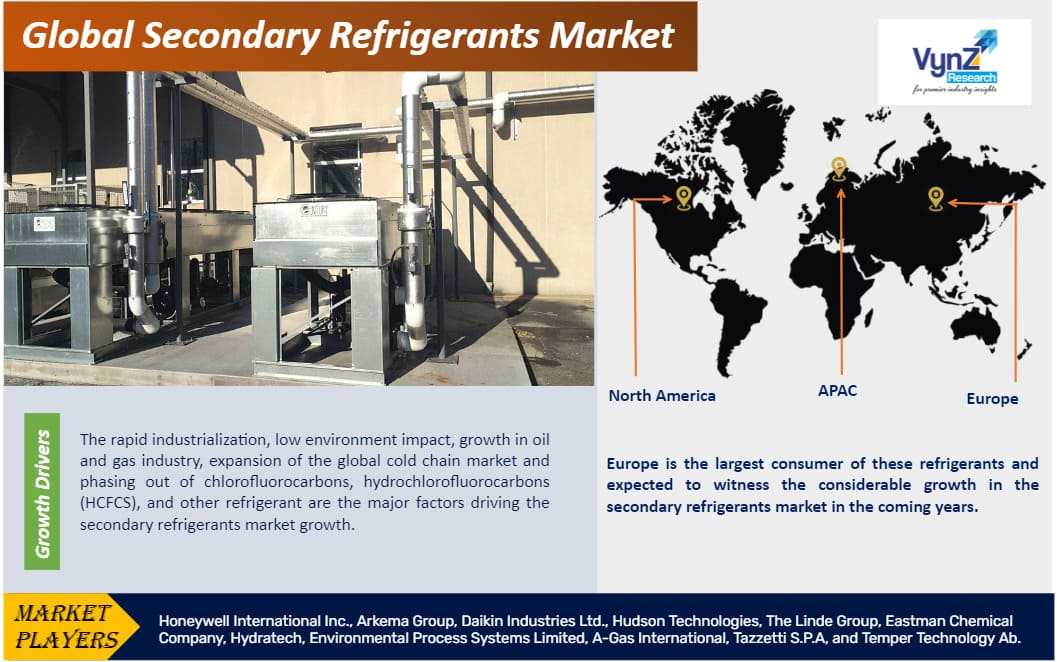| Status : Upcoming | Report Code : VRCH2025 | Industry : Chemicals & Materials | Available Format :

|

Global Secondary Refrigerants Market – Analysis and Forecast (2025-2030)
Industry Insights by Type (Glycol, Salt Brines, Carbon Dioxide), by Application (Industrial, Commercial, Heat Pumps, Air Conditioning)
Industry Overview
Secondary refrigerants are the fluids that are used to transfer heat from a substance which is being cooled by heat exchanger. After being cooled, the liquid is transferred through a series of pipes to the cooling load location, which is then returned to repeat the whole process. The secondary coolant circulates through a cooling system and cooled in a heat exchanger. They are generally non-toxic in nature in small amounts; however large amounts should be disposed in a proper manner.

The global secondary refrigerants market is anticipated to witness a strong growth in the coming years, owing to the increasing demand of these refrigerants due to strict environmental norms and rising demand for reduction in primary refrigerant charge.
Secondary Refrigerants Market Segmentation
Insight by Type
Based on type, the secondary refrigerants market is segmented into glycol, salt brines, carbon dioxide, and others. Glycol is further classified into propylene glycol and ethylene glycol. Salt Brines are further classified into calcium chloride, potassium formate, and potassium acetate. Among all these, glycol type category held the largest share in the overall market, owing to various advantages it offers such as; provide freeze protection for closed loop refrigeration systems, ventilation, air conditioning, water-based heating, and others. Along with that, glycol reduces the maintenance cost and has to be replaced after 3 to 5 years, fueling its demand in the market.
The carbon dioxide type category is anticipated to register the highest growth during the forecast period in the secondary refrigerants market. As carbon dioxide refrigerants are the environment-friendly type of refrigerants having zero ODP and minimal GWP. They also have good thermodynamics properties, are non-toxic, and also non-flammable.
Insight by Application
Based on application, the secondary refrigerants market is classified into industrial refrigeration, commercial refrigeration, heat pumps, air conditioning, and others. Of all these, industrial refrigeration application category is expected to hold the largest share in the market during the forecast period. This can be attributed to the increasing demand of these refrigerants in the industrial applications due to its environmentally acceptable properties. Also, various countries in developed and developing regions are in a dire need to reduce the carbon emission to protect the environmental damage, resulting in market growth.
Secondary Refrigerants Market Report Coverage
|
Report Metric |
Details |
|
Historical Period |
2018–2023 |
|
Base Year Considered |
2024 |
|
Forecast Period |
2025 - 2030 |
|
Market Size in 2023 |
$xx.xx Billion |
|
Revenue Forecast in 2030 |
$xx.xx Billion |
|
Growth Rate |
CAGR xx.xx % |
|
Segments Covered in the Report |
By Type, and By Application |
|
Report Scope |
Market Trends, Drivers, and Restraints; Revenue Estimation and Forecast; Segmentation Analysis; Impact of COVID-19; Companies’ Strategic Developments; Market Share Analysis of Key Players; Company Profiling |
|
Regions Covered in the Report |
North America, Europe, Asia-Pacific, Middle East, and Rest of the World |
Industry Dynamics
Secondary Refrigerants Market Growth Drivers
The rapid industrialization, low environment impact, growth in oil and gas industry, expansion of the global cold chain market, and phasing out of chlorofluorocarbons (CFCs), hydrochlorofluorocarbons (HCFCS), and other refrigerant are the major factors driving the secondary refrigerants market growth. The governments of various countries are aiming to phase out CFCs, HCFCs, and other similar refrigerant to protect the ozone layer, which are causing major harm to the layer and contribute to climate change. For instance, in 2010, the U.S. has already banned the production, import and use of HCFC, except for servicing needs of already existing equipment.
Secondary Refrigerants Market Challenges
High investment at the initial stages is identified as the major challenge in the secondary refrigerants market. For example, supermarkets are using carbon dioxide as a refrigerant due to their high energetic efficiency. However, the installation cost may become higher due to high pressure of carbon dioxide.
Secondary Refrigerants Market Industry Ecosystem
The secondary refrigerants market is highly fragmented, where major players are using various strategies such as merger, expansion, new launches, partnerships, and others to expand their footprints in the market.
Secondary Refrigerants Market Geographic Overview
Europe is the largest consumer of these refrigerants and expected to witness the considerable growth in the secondary refrigerants market in the coming years. This is attributed to the recent plans in Europe to phase out F-gases, which is expected to reduce the use of HFC gases at a significant rate. The authorities are pushing the users to switch from primary refrigerants to protect the environment, resulting in increasing demand of these refrigerants in the region.
Secondary Refrigerants Market Competitive Insight
Daikin Industries, Ltd. is a leading innovator and provider of advanced, high-quality air conditioning solutions for residential, commercial, and industrial uses.
Hudson Technologies, Inc. is a publicly traded company that is committed to providing products and services that reduce greenhouse gas emissions, increase energy efficiency, and promote sustainability to encourage understanding and ensure future generations inherit a healthy planet.
Honeywell International Inc., Arkema Group, Daikin Industries Ltd., Hudson Technologies, The Linde Group, Eastman Chemical Company, Hydratech, Environmental Process Systems Limited, A-Gas International, Tazzetti S.P.A, and Temper Technology Ab are some of the key players operating in secondary refrigerants market.
Recent Developments by Key Players
Honeywell is positioned to continuously expand its business in the sustainable aviation fuel (SAF) sector in China to tap the market potential, as the country's low-carbon transition goals breed massive opportunities for the chemical and aviation sectors, which produce high greenhouse gas emissions.
Daikin Air Conditioning Saudi Arabia (a leading manufacturer of Air Conditioning, Heating, Ventilation, & Refrigeration solutions) have partnered with Al-Hatab Bakery Factory 2 in Sudair Industrial Area, Saudi Arabia. This expansion shall implement climate-friendly refrigeration solutions in its business model in line with Daikin’s agenda to support its partners and customers in adopting advanced and sustainable cooling solutions.
Frequently Asked Questions
Purchase Options
Latest Report
Research Methodology
- Desk Research / Pilot Interviews
- Build Market Size Model
- Research and Analysis
- Final Deliverabvle
Connect With Our Sales Team
- Toll-Free: 1 888 253 3960
- Phone: +91 9960 288 381
- Email: enquiry@vynzresearch.com
Secondary Refrigerants Market
